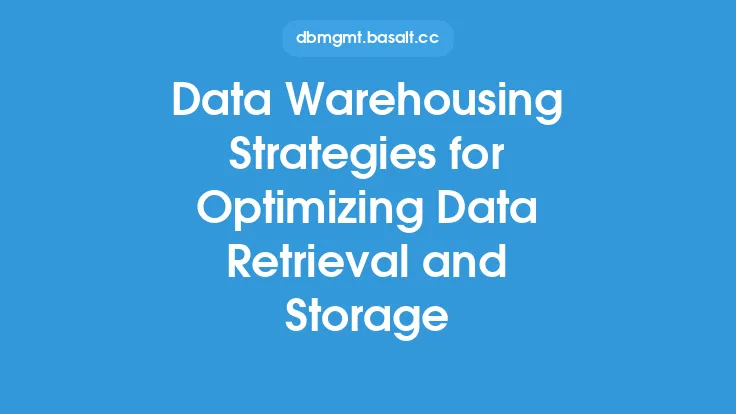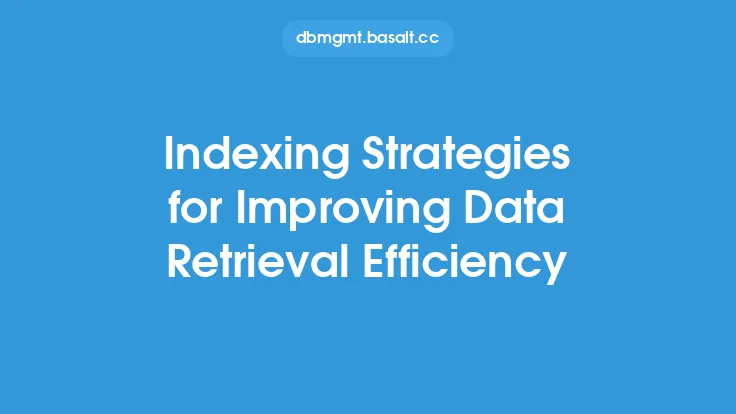When it comes to database design, one of the key considerations is how to optimize data retrieval. While normalization is often the default approach, denormalization can be a powerful strategy for enhancing data retrieval performance. Denormalization involves intentionally deviating from the principles of normalization in order to improve read performance, reduce the number of joins required, and simplify complex queries.
Introduction to Denormalization Strategies
Denormalization strategies are techniques used to optimize data retrieval by storing data in a way that reduces the number of joins required to retrieve the data. This can involve storing redundant data, pre-aggregating data, or using summary tables. The goal of denormalization is to improve the performance of queries that are critical to the application, while minimizing the impact on data consistency and integrity.
Types of Denormalization
There are several types of denormalization, each with its own strengths and weaknesses. Some common types of denormalization include:
- Data duplication: This involves storing the same data in multiple tables, in order to reduce the number of joins required to retrieve the data.
- Data aggregation: This involves pre-aggregating data, such as calculating sums or averages, in order to reduce the amount of computation required to retrieve the data.
- Summary tables: This involves creating tables that contain summarized data, such as daily or monthly totals, in order to reduce the amount of data that needs to be retrieved.
- Materialized views: This involves creating a physical table that contains the result of a query, in order to reduce the amount of computation required to retrieve the data.
Denormalization Techniques
There are several denormalization techniques that can be used to enhance data retrieval performance. Some common techniques include:
- Pre-joining: This involves storing data in a way that reduces the number of joins required to retrieve the data.
- Pre-aggregation: This involves pre-aggregating data, such as calculating sums or averages, in order to reduce the amount of computation required to retrieve the data.
- Indexing: This involves creating indexes on columns that are frequently used in queries, in order to improve query performance.
- Caching: This involves storing frequently accessed data in a cache, in order to reduce the amount of time it takes to retrieve the data.
Benefits of Denormalization
Denormalization can provide several benefits, including:
- Improved query performance: Denormalization can reduce the number of joins required to retrieve data, which can improve query performance.
- Reduced computation: Denormalization can reduce the amount of computation required to retrieve data, which can improve query performance.
- Simplified queries: Denormalization can simplify complex queries, which can make it easier to maintain and optimize the database.
Challenges of Denormalization
While denormalization can provide several benefits, it also presents several challenges, including:
- Data consistency: Denormalization can make it more difficult to maintain data consistency, since data is stored in multiple locations.
- Data integrity: Denormalization can make it more difficult to maintain data integrity, since data is stored in multiple locations.
- Storage requirements: Denormalization can increase storage requirements, since data is stored in multiple locations.
Best Practices for Denormalization
In order to get the most out of denormalization, it's essential to follow best practices, including:
- Identify critical queries: Identify the queries that are most critical to the application, and optimize those queries first.
- Use indexing and caching: Use indexing and caching to improve query performance, in addition to denormalization.
- Monitor performance: Monitor query performance, and adjust the denormalization strategy as needed.
- Maintain data consistency: Use techniques such as replication or materialized views to maintain data consistency, in addition to denormalization.
Conclusion
Denormalization can be a powerful strategy for enhancing data retrieval performance, but it requires careful planning and execution. By understanding the different types of denormalization, denormalization techniques, and best practices, developers can use denormalization to improve query performance, reduce computation, and simplify complex queries. However, denormalization also presents several challenges, including data consistency and integrity, and storage requirements. By following best practices and carefully evaluating the trade-offs, developers can use denormalization to optimize their database design and improve application performance.





